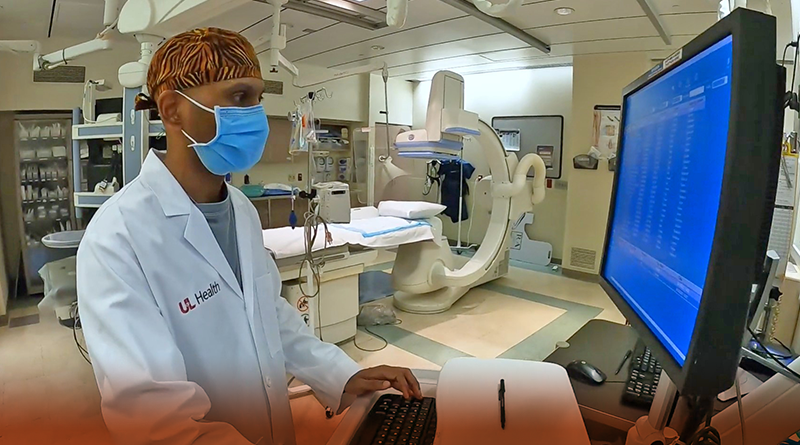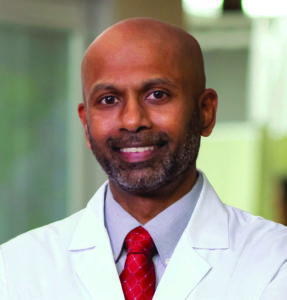 LOUISVILLE It is 3:00 am, and Chandhiran Rangaswamy, MD, an interventional cardiologist at UofL Health, is about to begin his day. By 4:00 am he will be at the hospital making his rounds. From 8am to 5pm, he will be in the clinic. After 5pm, he will perform any procedures scheduled for the day. Finally, he will go home, though some nights he is still on call for emergencies depending on the rotation with his colleagues.
LOUISVILLE It is 3:00 am, and Chandhiran Rangaswamy, MD, an interventional cardiologist at UofL Health, is about to begin his day. By 4:00 am he will be at the hospital making his rounds. From 8am to 5pm, he will be in the clinic. After 5pm, he will perform any procedures scheduled for the day. Finally, he will go home, though some nights he is still on call for emergencies depending on the rotation with his colleagues.
Rangaswamy would say this is all in a day’s work. Some of his patients call it heroic.
“My kids call him ‘Rango.’ He’s like a superhero to them,” Bob Valvano says. The well-known sportscaster and Louisville resident suffered a near-fatal heart attack, but was treated and saved by Rangaswamy.
Caring for others comes naturally to Rangaswamy, who comes from a family he describes as “a bunch of doctors.” His extended family includes a number of physicians, including a pediatrician, infectious disease specialist, and a geriatrician. His father was an engineer, and this mixture of engineering and medical influence impacted Rangaswamy’s career path.

A Louisville native, Rangaswamy graduated from the University of Louisville with a degree in chemical engineering. He attended the University of Louisville School of Medicine intending to become a cardiac surgeon. Midway through medical school, his focus shifted to cardiology.
After a cardiology residency at the Cleveland Clinic, he completed a cardiology fellowship at the University of Michigan before joining UofL Physicians. His practice includes general cardiology, medically managing conditions such as coronary artery disease, atrial fibrillation, and congestive heart failure. He handles emergencies such as heart attacks and procedures including angioplasty and stents. While most of his patients are ages 40 and up, he notes that there is an increasing number of younger patients from their late teens to early 30s.
“That’s a reflection of people being more aware of heart disease,” Rangaswamy says. “When they start having symptoms and they know they have a family history, they become more aware and alert to seeking medical attention before it gets too late.”
Asymptomatic Presentations
All too often, by the time patients present with symptoms, it is too late to prevent hospitalization. The commonly expected presentations are chest pain and shortness of breath, but Rangaswamy warns that diagnosis is seldom that simple.
“It’s interesting that the textbook presentation of heart disease we are taught in medical school is usually not what patients present with,” he says. “Probably 15 to 20 percent of patients will present with the textbook presentation. Many others will present with atypical symptoms that we’re taught are not likely to be heart related.”
Rangaswamy says some patients will have shortness of breath only. Others might have atypical pain easily dismissed as a muscle pull. Some might have back, jaw, or arm pain.
“These are people who end up having significant disease that requires either an angioplasty procedure or a stent,” he says. “The reason why we know these are atypical presentations is because after we fix their blockage the symptom is resolved.”
Rangaswamy says comorbidities such as diabetes and obesity contribute to these misleading presentations. For example, diabetic neuropathy can alter or even eliminate the perception of pain. COVID-19 has also brought about another set of cardiac issues.
“We’ve seen quite a few patients with cardiac complications that are directly related to COVID-19,” he says. “Quite often these patients have tested positive for COVID after we’ve done their procedure. There’s something about the virus that triggers heart attack or atrial fibrillation. As we learn more about COVID, we will start realizing that there are not only significant cardiac complications, but probably long-term consequences that we will see over the next couple of years.”
Also over the next few years, Rangaswamy hopes that his colleagues and patients will become more familiar with what cardiologists do.
“The breadth of what we do is vast, and it would be nice if we could dispel the myth that all we do is take care of coronary disease and arrhythmias,” he says. “You can potentially get a lot taken care of by simply sending a patient to a cardiologist.”
Diagnostic and Therapeutic Breakthrough
A potentially life-changing procedure Rangaswamy now performs is implanting a CardioMEMS™. He describes the device, which is about the size of a paper clip, as a hybrid diagnostic and therapeutic tool. A good candidate for CardioMEMS is a patient who has been hospitalized with a diagnosis of congestive heart failure.
“When congestive heart failure begins, the first marker is an elevation in the pressures within the heart and lungs,” Rangaswamy says. “As those pressures continue to rise, eventually you start developing fluid retention, which leads to symptoms, which then lead to hospitalization. We rely on things like daily weight to determine when a patient might be going into congestive heart failure. We have now realized that by the time we wait on someone to gain two pounds and become symptomatic, it’s usually too late and they have one foot in the door to the hospital to be admitted. If we can identify congestive heart failure before it becomes symptomatic, we can treat it and reverse the process and prevent hospitalization.”
The CardioMEMS device is typically implanted in the left main pulmonary artery via the femoral vein. Once implanted and calibrated, the device constantly monitors the pressure within the heart and lungs. Patients are given a special pillow with an embedded digital tracking device to lay on for 10–15 seconds every morning. The pillow registers the pressure reading and transmits the data to Rangaswamy’s office, where the readings are tracked. If the pressures trend upward, the medications can be adjusted to help reduce the fluid and prevent hospitalization.
“This helps the quality of life for these patients because they don’t have to spend so much time in the hospital,” Rangaswamy says. “It improves mortality because we know the natural progression and history of heart failure is that for every hospitalization, survival is decreased.”
The UofL Physicians cardiology team is the largest CardioMEMS program in the state, having performed approximately 110 implants over the last to two and a half years. Rangaswamy himself has performed more than 100 of the procedures but would like to do many more. Unfortunately, most of the major insurance companies have yet to approve the device and will not cover payment for the procedure.
“If we can get those insurance carriers to open up, I think we have a tremendous potential to reduce heart failure admissions, improve quality of life, and have a big impact on healthcare dollars,” he says. “The population that would benefit from this device is enormous.”
Rangaswamy says that CardioMEMS not only reduces hospitalizations and death, but also helps prevent misdiagnoses.
“CardioMEMS gives us a way of quickly tri-aging the patient,” he says. “If the pressures are in the normal range, it’s not congestive heart failure and we look for something else.”
Rangaswamy wants people to understand that the signs and symptoms of heart disease are not always obvious. Every patient and every case is unique. So is every day except that, for Rangaswamy, they all start at 3am.

